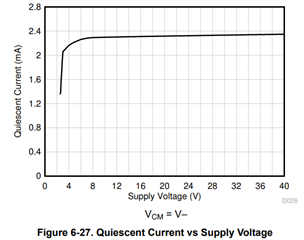Other Parts Discussed in Thread: OPA2310
Hello,
the datasheet does not specify the operating supply current per channel. There is a value of 2.4mA mentioned in Feature section. I guess it is a typical value. We plan to replace another TI Opamp with the OPA2992 and supply current is critical parameter. For other devices TI specifies the supply current with typical and maximum values. Furthermore, what is the max. achievable output current.? The datasheet specifies short circuit current only (65mA). Figure 6-16 is a graph to plot the voltage drop versus load curent (sourcing) for different temperatures but basically with typical values .
Thanks im advance!
Best Regards Andreas



